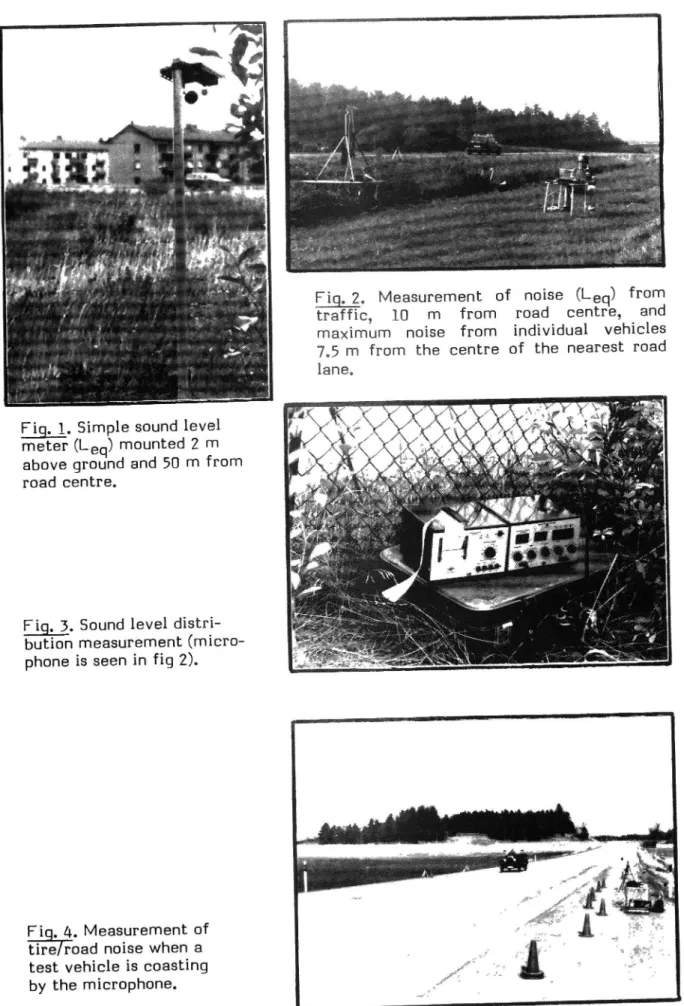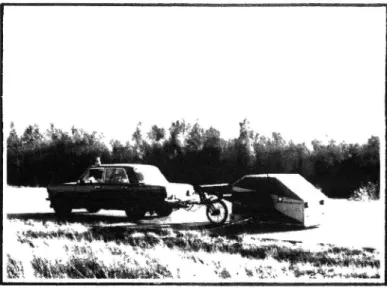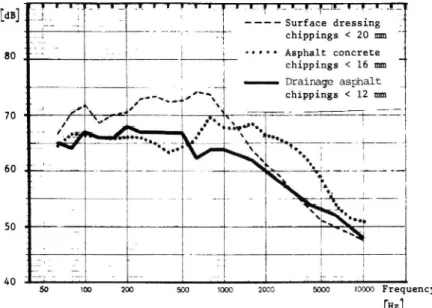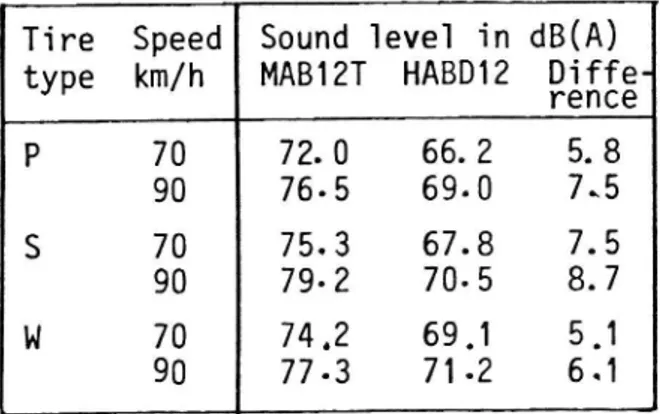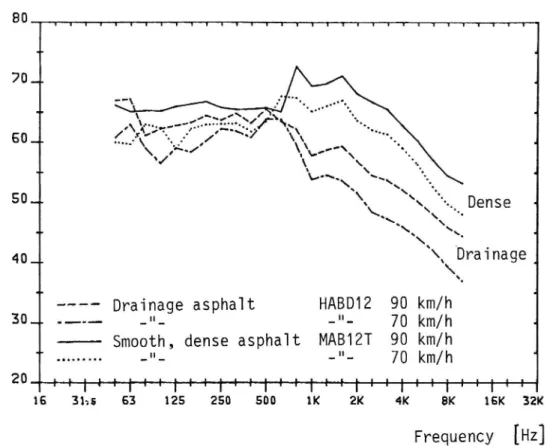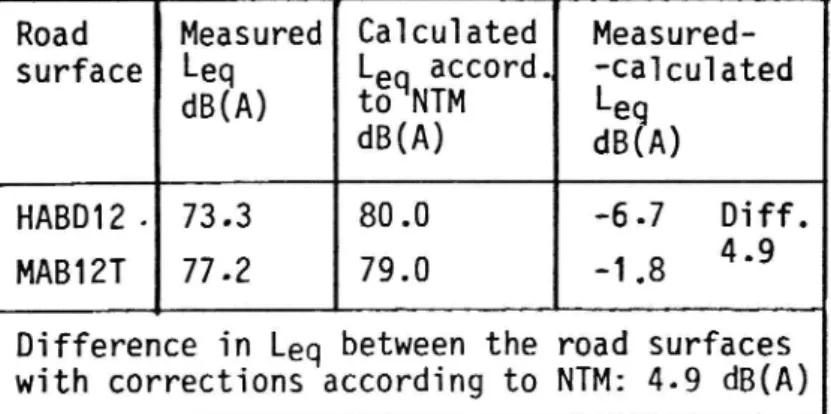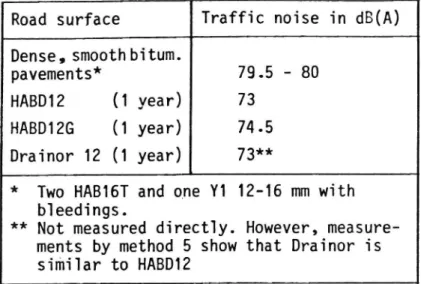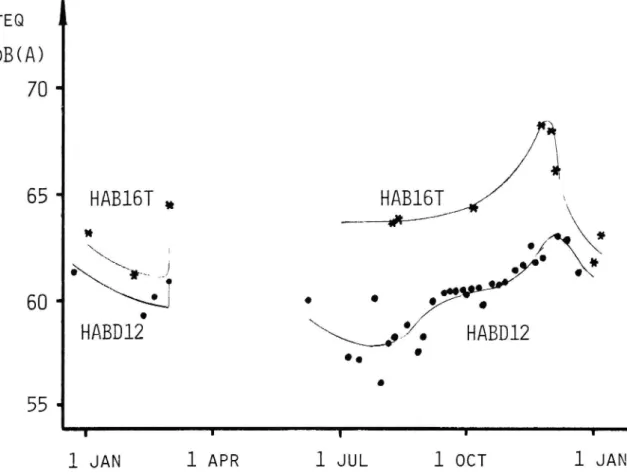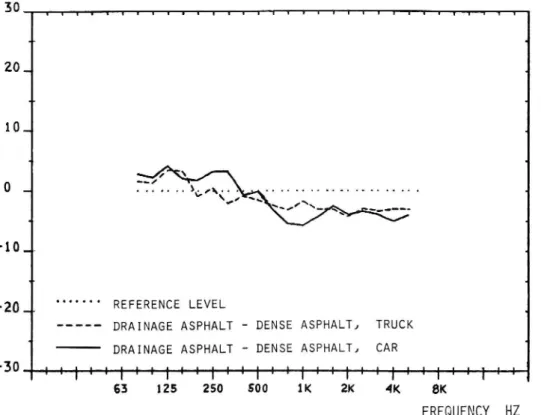Nr 95 o 1984
95
§Allnm
Statens väg- och trafikinstitut (Vl'l) - 581 01 Linköping
Swedish Road and Traffic Research Institute - S-581 01 Linköping - Sweden
Reduction of Tire/Road Noise by
Drainage Asphalt
by Ulf Sandberg
Presented at the International Seminar on Tire Noise and Road Construction, ETH, Zurich, Febr. 1984
Nr 95 . 1984
95
Statens väg- och trafikinstitut (VTI) - 581 01 Linköping
Swedish Road and Traffic Research Institute - S-581 01 Linköping ' Sweden
Reduction of Tire/Road Noise by
Drainage Asphalt
by Ulf Sandberg
Presented at the International Seminar on Tire Noise and Road Construction, ETH, Zurich, Febr. 1984
REDUCTION OF TIRE/ROAD NOISE BY DRAINAGE ASPHALT
ULF SANDBERG
SWEDISH ROAD AND TRAFFIC RESEARCH INSTITUTE
8 581 01 LINKÖPING, SWEDEN
PRESENTED AT
THE INTERNATIONAL SEMINAR ON
TIRE NOISE AND ROAD CONSTRUCTION
ETH, ZURICH.
FEBR. 1984
HISTORY*
Road traffic noise has become one of the major environmental problems of this
century. It is, however, a much older problem; already the old Romans were
complaining over road traffic noise as their carriages were rattling over uneven pavements causing serious annoyance (ref. 1). This is perhaps the earliest indication we have that the tire/road interaction really causes annoying noise.
However, pe0ple had more important things to worry about, and no significant measures were undertaken to reduce this noise. First at the end of the 19th
century, the invention in 1888 by the Irish veterinarian J.B. Dunlop of a practical
air-inflated rubber tire radically changed the tire/road noise emission. The
increased transportation work also required smoother and more even roads. In practice, this led to that tire/road noise soon was negligible as a traffic noise component in relation to engine noise.
The increased public concern over the tremendous increase in traffic after the
second world war, as well as the vehicle drivers requiring lower cab noise, soon
forced the manufacturers to produce quieter power-trains on their vehicles. In the period 1955 - 1965 tire/road noise again was observed to be of importance, a tendency which was amplified by the ever-increasing Speed of highway traffic. Research on this matter was initiated first in the latter part of the sixties,
although a handful of reports were presented also in the preceeding ten-year period. The work was then often concentrated on tread pattern Optimizations
-mainly randomization of the block impact period - by the tire industry itself as
well as a few investigations by acoustic consultants on behalf of environmental authorities.
The road surface deveIOpment has been of great importance for tire/road noise emission. During later decades this has mainly concerned the three following develOpment trends.
1. With the purpose of reducing hydr0planing hazards, grooving of cement
concrete surfacings has become common (however, not in Sweden).
2. With partly the same purpose, partly for economical reasons, a change-over
from smooth aSphaltic surfacings to rough surface dressings has occurred on a
large portion of the Nordic road network and in some other Eur0pean countries.
3. In order to utilize a lot of advantages, the use of porous drainage aSphalt
pavements has increased.
The first trend has essentially increased tire/road noise emission; often with matching loud protests from the pe0ple living close to these roads (and the drivers
as well) as a result. Also the second trend has increased the noise somewhat
-eSpecially indoors - while the third trend appears to have a considerable potential
for reduced traffic noise.
That drainage pavements could reduce tire/road noise was pointed out in British
and American investigations already 10 years ago. However, there was never any break-through for these pavements as noise reduction measures. During the last 5
years there have been investigations on this particular problem also in Sweden
(ref. 2, 3). In the years 1981-83 drainage pavements were first used as noise reduction measures in Sweden.
This paper is reporting only results obtained at the Swedish Road and Traffic
Research Institute (VTI). Apart from this, some related measurements have been made also by the Gothenburg Commune and the Swedish Road Administration in cooperation with IFM Akustikbyran AB. These results have, however, not been reported in English.
TIRE/ROAD NOISE - A TRAFFIC NOISE SOURCE
Tire/road noise is highly dependent on vehicle speed. Normally, it increases by
9-12(A) per doubling of Speed. On the other hand, power train noise* has a lower speed dependence seen over the "normal" speed range, due to that the engine
Speed is adjusted to the cruising Speed by gearbox changes. Because of this, the portion of tire/road noise is increasing at higher cruising speeds. At a certain
"crossover" Speed, tire/road noise can be equally loud as power-train noise and
above that Speed soon become dominant. This crossover Speed is ca 30-50 km for
cars and ca 40-80 km/h for trucks of recent models, provided the driver is utilizing "normal" engine speeds without extreme accelerations. For traffic as a
whole, tire/road noise seems to dominate at posted Speeds of 70 km/h and higher;
for certain conditions even at 50 km/h of posted Speed (ref. 4). NOISE GENERATING MECHANISMS
The generation of tire/road noise is of interest in order to understand the results
presented later. Based on a synthesis of earlier work the following hypotheses
about noise generating mechanisms have been established:
Power-train noise includes all other significant noises of a vehicle but
1. Tread radial A. Impact of tire tread blocks or other pattern vibration on road surfaces
mechanism
B. Impact of road surface texture on tire tread
Z. Air resonant A. Pipe resonance
mechanism
B. Helmholz resonance
Both A and B might be excited either by simple
compression/expansion of entrapped air or by tread
tangential vibrations form stick/Slip motions
C. Pocket air pumping (this may also be a Special case of B)
In addition to this we have some amplitude influencing effects:
I. The horn effect
II. Sound absorption in the road surface
III. Mechanical impedance effect
COMMENTS - Tread radial vibrations are caused by small deflections in the tire
tread due to the impact forces, and radiate as sound after low-pass filtering in the
tire.
The pipe resonance is due to standing waves which occur in the grooves of the tire tread.
Concerning the Helmholz resonance, the volume of air in a cavity will act as a Spring resonating with the mass of air in the "throat" between the cavity and the
external air. In a tire axle fixed coordinate system a cavity in the tread is travelling out of the road contact area and up the tire circumference. Then the resonance frequency and probably also the amplification are changing with the revolution.
Air pumping occurs when a cavity is closed and Opened and the air is compressed/expanded with such a speed as to cause great air turbulence and thus noise. The Helmholz resonance might amplify the noise.
Between the curved tire tread fore and aft of the tire/road interface and the road surface there is a Space which forms an acoustical horn which increases the radiation efficiency backwards and forwards.
The stiffness of the road surface, or the matching of mechanical impedance
tire-to-road, influences the tread block or road texture impact so that it might be amplified (stiff road) or attenuated (soft road).
Mechanism No. 1 is limited to rather low frequencies (below 1 kHz generally) and mechanism No. 2 seldom occurs below 1 kHz. Mechanism 28 and 2C Should be most important at the trailing edge, accentuated also by the horn effect.
Thus, the generating mechanisms encompass a lot of interesting acoustical phenomena of fundamental nature, but altogether form a very complicated
MEASUREMENT METHÖDS
Altogether seven different measurement methods have been used to determine
the influence of the drainage pavements on noise. These are: l.
4.
Measurement of traffic noise (Leq) 50 m from the road
50 m from the centre of the road an integrating sound level meter, type
Metrologger db306A, has been located at different times before as well as after the pavement was changed from dense to drainage aSphalt concrete. The
drainage aSphalt effect is considered as the difference before - after. The equivalent A-weighted sound level (L ) has been measured at three different
locations along the road, at a heigf of 1.5-2.5 m above ground (for two
locations) and 10 m above ground (one location). The measuring period has normally been 24-100 h without interruption. The values are corrected for variations in traffic intensity and Speed. See fig. 1.
Measurement of temporal characteristics of traffic noise 10 m from the road
Noise from the entire traffic stream has been measured using a microphone 10
m from the road centre and 1.2 m above the road plane. The signal has been A
weighted with time constant "Fast" and its level (amplitude) distribution has
been analyzed in a statistical sound level analyzer type B&K 4426/2312. See fig. 2 and 3. The temporal characteristics have then been discribed by its level distribution as well as the normal traffic noise descriptors L , L , L , and
L9 (L is the level which has been exceeded x % of the time)?qf\ rrligasufgment tinge år about 2 hours has been used during which also traffic intensity, composition and Speed has been recorded.
Measurement of traffic noise (Lmax) 7.5 m from the road
At a location of 7.5 m from the centre of the closest road lane and 1.2 m above road level, a sound level meter type B&K2209 with micrOphone
B&K4165 has been mounted. The sound, together with data concerning type of
vehicle and vehicle speed, was recorded on tape for later analyses. See fig. 2. When single vehicles have passed, the maximum sound level as well as
frequency Spectra at the time of maximum sound level, have been measured. In this way, statistics on the maximum sound levels weighted in different ways as well as the Spectrum can be produced for different Speeds and vehicle
classes on each road surface. The time constant is 0.25 s (correSponding to "Fast"). Each measurement covers 80-130 cars and 50-100 heavy vehicles. Measurement of tire/road noise when coasting by a micrOphone
Instruments and measuring positions have been the same as in measurement
type 3. However, measurements have been made only on Special test vehicles
coasting by the microphone with the engine switched-off. See fig. 4. These vehicles have been coasting at 90 and 70 km/h, in certain cases also 50 and 30
km/h, and have been equipped consecutively with these tire types:
Pattern-less (smooth) reference tire from PIARC
Summer tire, type Firestone Cavallino Sl Summer tire, type Michelin XZX
Winter tire, type Firestone TC asym. Winter tire, type Gislaved Frost
GS Winter tire, type Gislaved Frost, studded with 108 studs.
All tires were of type steel radial, dimension 1655R15 and were run 300-3000 km. Each measurement series has included at least five averaged coast-bys.
O E Z U T J
Fig. 1. Simple sound level
meter (Leq) mounted 2 m
above ground and 50 m from road centre.
Fig. 3. Sound level
distri-bution measurement (micro
phone is seen in fig 2).
Fi . 4. Measurement of tire7road noise when a test vehicle is coasting by the micrOphone.
Fig. 2. Measurement of noise (Leq) from
traffic, 10 m from road centre, and
maximum noise from individual vehicles 7.5 m from the centre of the nearest road lane.
F'ig. 5. Trailer for tire/road
noise measurement (belongs
to the Technical University
of Gdansk). Inside the enclos-ure there is a test tire, close
to which a micrOphone is mounted.
Fig. 6. Measurement of sound propagation from a loudspeaker on the road surface to a micrOphone on t0p of the tripod. The tripod is covered with absorbing material to avoid
reflections. Fig. 7. Measurement of noise emission from a stationary vehicle. Microphone at position similar to coast by measure-ments.
5. Measurement of tire/road noise close to the tire (using trailer)
A Special trailer, from the Technical University of Gdansk, utilizing a test tire screened from outside noise by an enclosure having acoustic absorbents on the
inside has been used (ref. 5). The speeds have been SD, 70 and 90 km/h. The
micrOphone has been mounted 200 mm from the tire sidewall, normal to the rolling direction, and 100 mm above road level. For each run of 4-16 s duration (normally 16 3) the recordings made in the towing car have been analyzed later
in the laboratory to obtain frequency Spectra in third-octave bands and
A-weighted overall levels. Each run has been repeated at least once, for each
tire/road/speed combination. The same tires as Specified above have been used as test objects. See fig. 5.
6. Measurements on stationary vehicles
The measurement setup has been similar to that of measurement No. 3, except
that in this case the test vehicles (one car and one truck) have been positioned
stationary on the road closest to the micr0phone. Only engine noise, incl. fan
and exhaust, has been recorded in this way in a range of different engine
Speeds. Normally, ca 16 3 of measuring time has been used. By comparing similar measurements over one dense and one drainage pavement, the effect of possible sound absorption by the drainage can be seen. See fig. 7.
7. Measurement of sound absorption over a road surface
A loudspeaker has emitted wide-band noise in a position very close to the road
surface; a position meant to simulate a tire noise source. 7.5 m away, 12 m
above the same road surface, a micrOphone has measured the received noise
which later has been frequency analyzed. By comparing such measurements over different surfaces, the "drainage" effect upon noise pr0pagation from the source to the microphone can be detected. See fig. 6.
The macrotexture of each road surface has also been measured. Due to Space
limitations these macrotexture values are not included here.
RESULTS
Measurements 1978 on highway No. 12, Simrishamn
Using method No. 4, tire/road noise was measured for tires P, S and W on a road surface of type Open-graded emulsified aSphalt mix (AEBlZÖ) with max. 12 mm chippings. This surface, which then was two years old, was compared to several
others, see fig. 8 and 9. Please note, however, that in fig. 8 the values concern
Leq during a 75 m long measurement distance and not Lmax.
It appears in the figure that the drainage aSphalt AEBlZÖ gave 5 dB(A) lower
tire/road noise emission than "common" types of surfaces of correSponding age (the bars 2 4 from the left, which are 3-0. dB(A) higher than AEBIZÖ, concern occasional and brand new surfaces). As an extreme case it can be seen that the
much smoother cement concrete caused 8 dB(A) higher noise level than the drainage aSphalt. Fig. 9 shows that the greatest effect is in the frequency range
600-6000 Hz. See further ref. 2.
A sound propagation measurement (type 7 above) showed that the noise reduction
by the surface is to a great extent occurring in the path from source to
micr0phone (ref. 6, "). One can therefore predict that the surface is capable of
attenuating also other types of noise prapagating close to the surface, for
instance engine noise. Then the efficiency should be highest in the range 500-1000
TIRE/ROAD
NOISE LEVEL dB(A) CEMENT 76- CONCRETE SURFACE ' DRESSING _ 74 RUBBER BITUMEN ASPHALT CONCRETE % ) DRAINAGE _ SURFACE
72-
_?
T "*
70-
__
68" ; 0166
?
N o o + |__ |__ + ,._ + 3 E n? 5 å % 29 29 a 8 L:, S oo ; 29 2 I9 x9 &, 1 F | |: T | ('\, N &: cl: 2 m en en ca co m om 03 55 5 55 om E) a r- * *" * E u.: <1: (i <1 <1 <1: (i <2 D :3 :> D I) 3 < ( < i u.] <1: 2 Z I I I I Z o: o: 0C 0: o: 0: > >- >- > inFig. 8. Tire/road noise measured on different road surfaces. The values concern
the Le over 75 m of a car coasting by the microphone. Summer tire type S (see text) run at 90 km/h.
[dB] __ T; I I _ _j I _l _l_ T T F ' l_ _, _!__ SI I___ |__ ,_ ___! l _ I __ lw _!_
* 4___ __ __ ' I L. -- Surface dressing '.1
fit * _ _.__ " ' Ti chippings < 20 mm _
Fig. 9. Tire/road noise. so "5 5 " ' -- ' L______;'__l ' Asphalt concrete j}chippings < 16 mm
on a drainage aSphalto o ' i _ Dra.lna e a haltS
(AEBlZO) compared to w P... JMA-fJ- chippiggs <p12 mm
two conventional sur- " J fx -/ * ___ - ___ dj #
f h 70 I, Ä'r' ?. ' 7- __
. . 00.8. .,... I
aces, one very smoot __ a? få. x:" ( '..., .
aSphalt concrete (HABl6T) fw "**-;;.»V i *:"*"*'*w. f*** *f m& '. T and one very rough 60 __ ._ ______ ___ &_ ______'I_________
surface dressing (Yl 12-16).
E '
*
't.
*
Frequency Spectra in third. _ - ~ -- \ + f _J.. * octave bands (Lmax)- Tire so . , &&"?
type 5, Speed 90 km/h. _" _ ä
4 . __ _ _ i i
E5 5
-
- '
_
4
_
; E1 1
i
i
40 50 100 200 500 1000 2000 5000 10000 Frequency
Measurements 1980 on highway 23, Höör
Measurements of type a (coast-by) were made utilizing a Goodyear Grand Prix S
tyre, dimension 18SSR14. Tire/road noise on the two following surfaces were
compared:
0 HABD12, a one year old drainage aSphalt concrete
0 MABlZT, an eight years old dense (smooth) aSphalt concrete
Both surfaces had chippings of size max. 12 mm. The results showed that for
frequencies above 1 kHz the drainage aSphalt was ca 5 dB quieter than the dense
aSphalt, while the relation was reverse for frequencies below 600 Hz (ca 3 dB
difference). The overall levels differed 3.4 dB(A) to the advantage of the drainage
aSphalt. See ref. 3.
Thus, it appeared that this surface was less efficient for reduction of tire/road
noise than the previously reported. In ref. 3 the grading curves for these
pavements are compared and it can be seen that the less efficient variant had a
grading curve which is typical of a considerably more closed surface as well as it contained bigger chippings. These are probably the main reasons for its smaller noise reduction.
Measurement 1982 on highway Eli, Norrköping
Utilizing tires P, 5 and W, coast-by measurements (type 4) were made on these surfaces:
0 HABD12, a two months old drainage aSphalt concrete. Road E4 south of
Norrköping
o MABlZT, an eight years old dense (smooth) asphalt concrete with very smooth texture. Road 796 at Gistad.
The drainage aSphalt used here was considerably more open textured than that described in the previous paragraph. Table 1 and figure 10 show the main results.
For tire 5 the noise reduction of the new drainage surface is 7-9 dB(A) and for
tires P and W 5-7 dB(A). This is the highest reduction measured so far. The
complete frequency range except 500 Hz is influenced positively, above 700 Hz
the reduction is remarkable.
Table 1. Tire/road noise (Lmax) measured on a new drainage aSphalt (HABDlZ)
and an old dense aSphalt (MABlZT).
Tire Speed Sound level in dB(A)
type km/h MABlZT HABD12 Diffe-rence P 70 72. 0 66. 2 5. 8 90 76-5 . 7.5 S 70 75.3 67.8 7.5 90 79-2 70-5 8.7 w 70 74.2 6 . 5.1 90 77-3 71-2 6.1
10
The curves of fig. 9 concern the same tire (5) and Speed (90 km/h) as those of fig.
10, so a comparison is possible. Then it appears that the new drainage aSphalt,
MABD12, is more efficient than AEBlZO.
In a later chapter the reasons for the noise reduction are discussed.
dB
80 . ..T. .. se
- s
s
... s
.-.
T
1
70... ll
60... J1"
i
501-
'En Dense l
J"XxLDrainage
4OTL \\ J .. J7
--- Drainage asphalt
HABD12 90 km/h
30.- ___-
- _
70 km/h
l
l Smooth, dense asphalt MABlZT 90 km/h J
' ... _"- - - 70 km/h
20sli11f11issi4%i:¢frrir:i isi:1111
16 31:5 63 125 250 500 1|( 2K 4K BK 16K 32K
Frequency [Hz]
Fig. 10. Frequency spectra for tire/road noise on one dense and one drainage aSphalt surface (Lmax during coast-by). Speeds: 70 and 90 km/h. The curves concern tire type S (see text).
Measurements 1983 on highway Eli, Norrköping
In these measurements the above described drainage aSphalt was compared to an
equally old (1 year) dense aSphalt which was located on the same road. Three types of measurements were made, namely by trailer (type 5), L in normal traffic (type 2) and L mxa from individual vehicles (type 3). eq
The trailer measurements gave the following results. There is no significant
A-weighted sound level difference (within 1 dB(A)) for tires S, M and W. However, the spectra are different as the drainage pavement gave higher levels below 1300 Hz but lower levels above that frequency. For the rougher treads of tires G and G5 the drainage pavement is 2 dB(A) quieter than the dense, a relation which is
reversed for the smooth tire P. The reason for these results is believed to be that the drainage pavement is much rougher than the dense and that the "smoother" treaded tires are more sensitive to the texture of the Special near-field
micrOphone location in the trailer method. For the "rougher" treaded tires it is more important to "break-up" the tread impact and to provide drainage of the high air content in the tread; something that is well provided by the drainage
pavement.
The trailer method, especially the micrOphone position, is of controversial value in this case, partly because of the tire noise directivity, partly because of the
small influence of absorption in the surface when the distance between source and
micrOphone is so small.
From the traffic noise measurement (type 2) it appeared that the drainage aSphalt caused 5 dB(A) of lower traffic noise. Then it should be noticed that the traffic intensity was very high, the heavy vehicle portion 15 25% and the average Speed 70-75 km/h. By comparing with calculated noise levels according to the Nordic Traffic Noise Model (NTM) noise differences caused by differences in the traffic have been compensated, see table 2.
Table 2. Measured and calculated traffic noise levels (L ), the latter according
to NTM where corrections are made forq traffic composition differences. Air temperature was 20°C.
Road Measured Calculated
Measured-surface Leq
Leq accord. -ca1cu1ated
dB(A)
dB(A)
HABDlZ. 73.3 80.0 -6.7 Diff.
MABiZT 77.2
79.0
-1.8 4'9
Difference in Leq between the road surfaces
with corrections according to NTM: 4.9 dB(A)
To achieve the obtained traffic noise difference it is necessary that the tire/road
noise differences be as big as measured earlier (see the previous paragraph).
Measurements 1983 on highway E4, Nyköping
Measurements were made according to the methods 2,3 and 5. So far, the results
are somewhat preliminary, minor corrections might be introduced later. However, the traffic noise measurements (type 2) gave the preliminary results shown in table 3.
12
Table 3. Results of traffic noise measurements (L ) made along different road
surfaces on EB, Nyköping. The values areeåorrected to a distance from
road centre of 10 m, 1000 vehicles/h and 10% heavy vehicle portion
(according to NTM). However, corrections for speed differences have
not yet been done. Posted Speed is 110 km/h, air temperature 23-26 C.
Road surface Traffic noise in dB(A)
Dense , smooth bi tum.
pavements* 79.5 - 80
HABD12
(1 year)
73
HABDIZG
(1 year)
74.5
Drainor 12 (1 year)
73**
* Two HAB16T and one Y1 12-16 mm with bleedings.
** Not measured directly. However, measure-ments by method 5 show that Drainor is similar to HABD12
Measurements 1982-83 on highway E4, Timrå
This object is a motorway dividing the town of Timrå (north of Sundsvall) into two parts. It is investigated in detail what happened to the noise when the old dense
aSphalt concrete (HABléT) was changed to a draina e aSphalt of type HABDlZ.
The main part of the road was epaved with 70 km/m (location 2) while a shorter part was repaved with 90 kg/m giving a thicker wearing course. The recipe and the thickness were designed by experiences from the successful trial at
Norrköping (see above).
Noise measurements have been made in different ways. From August 1982 to
February 1984 the traffic noise has been measured frequently on three locations;
all of them 50 m from the road centre which is the distance at which the most severe disturbances to the pe0ple living at the roadside occur. Locations 1 and 2 are using 2 rn micrOphone heights above ground in free field while location 3 has the micrOphone at a facade 10 m above the ground. Measurements according to type 1 have been made at different seasons, temperatures, dry, wet or icy road
conditions and traffic intensities. The results from location 1 are given in fig. 11.
Concerning the old pavement, HABl6T, one can see that the noise level was
increasing during the late autumn when the studded tires were used increasingly (ca 4 dB(A)). When the snow came, most cars were equipped with studded tires
and a dramatically decrease in noise was observed as the snow depth increased. At the end of February much of the snow was removed (mechanically) which immediately increased the noise.
DB(A)
70
-65
HAB16T ,
HAB16T//
6D u . 0 / O
HABDlZ
&; .
HABDlZ
.. '
55
-l JAN l APR l JUL l OCT l JAN
Fig. 11. Variations over two years in traffic noise (Le ) at location 1. Measurements on the old, dense pavement HABléT were made in Aug. 1982-Feb. 1983, whereas measurements on the new, drainage aSphalt HABDlZ were made in June 1983-Feb. 1984.
The drainage asphalt was laid in June and afterwards the traffic noise levels were reduced by 4-7 dB(A). A relatively high variation can be seen over the summer
period and it has een detected that this is due mainly to temperature variations. The variance R was 0.65, i. e. 65% of the variation for all the locations is
explained by temperature. The temperature influence on the measured values is
about 2-3 dB(A) decrease in noise for 10-150C increase in temperature. This can
be caused either by sound path disturbance from temperature and wind gradients or by some process in the road surface, e.g. the surface gets softer at higher
temperatures which might lead to less tire/road noise. The temperature effect will be investigated more during the summer of 1984.
An increase in traffic noise, matching studded tire introduction, can be seen also on the drainage aSphalt. When the snow comes the noise is again decreased but not as much as for the old surface. This is probably due to that on the drainage aSphalt the tire/road noise is already reduced to such a low level that there is not so much to be reduced by screening and absorption by snow.
14
In conclusion, for the first half year of the drainage aSphalt the following noise
reductions were achieved in relation to the old, dense surface: At location l (sound path over quite hard soil): 4-7 dB(A) o At location 2 (sound path over grassland): 3-6 dB(A)
At location 3 (sound path over aSphalt, but micr0phone close to facade and 10
m above ground): 5-8 dB(A)
Note that at location 2 the road0surface was thinner. The higher noise geductions
are valid for temperatures 20-25 0C and the lower for temperatures 0- 15 C.
At location l measurements according to methods 2 and 3 have been made as
well, the results of which are not yet fully analyzed. Measurements with the
trailer (method No. 5) were also made on the thick and thin drainage aSphalt and
compared to the old, dense surface. It appeared that partly the thicker surface
reduced noise more than the thinner, partly the thickness seems to determine the
frequency where the reduction is maximum. See fig. 12. From this fact, one can Speculate that it might be possible to "tune" the efficiency by manipulating the
surface thickness.
One more measurement was made at location ], namely on stationary vehicles (method 6). The purpose was to determine whether other noise than tire/road noise could be reduced by the drainage aSphalt.
In fact, it appeared that even for the stationary vehicles there is a noise reduction on drainage aSphalt. See fig. 13. Vehicle noise was reduced by ca 3 dB over the frequency range 600-5000 Hz, whereas a certain amplification occurred at
frequencies below 300 Hz. The latter effect may be due to the micrOphone
location and not necessarily be representative also for greater distances. OTHER CHARACTERISTICS THAN NOISE
This paper deals only with the noise characteristics of drainage pavements.
However, a few notes on the Swedish experience concerning other characteristics
may be motivated.
It is obvious that wet skid resistance - particularly hydrOplaning resistance - is better on a drainage pavement than on dense pavements. If the design has been good, there should be no water above the pavement asperities. Wet skidding
accidents have consequently been reduced on places where this kind of pavement
has been laid due to previous problems with hydr0planing.
In Denmark and the Netherlands skidding problems worse than on dense pavements have been noticed when roads have got icy due to rain in cold weather. The same problems have been noticed a few times in Sweden but have been overcome by
pr0per de icing measures (salt). It has been claimed that some salt is "lost" in the
porosities requiring more salt for the same de-icing effect on the surface relative to dense pavements. There are also times when the reverse has happened so, totally, the drainage pavements have not been worse than the dense.
Concerning construction economy, there are different views - some people think the drainage pavements are cheaper than the dense, some pe0ple think they are
dB 30
20j.
10
q.
THIN DRAINAGE ASPHALT (70 KG/MZO
0 _ _ DENSE, ASPH.I
,Å/
/' s J\
CONCRETE
_____',,»v* d,, N*x;_,»-- f" !___,_____
+ f s _.__, J
to-T
THICK DRAINAGE ASPHALT (90 KG/M2)
*
1--201.
J
"30 LL] lllllllllllll L l'LlLllLllLLLl I I I I I I I I l I I I I I T I I ' I I " I I 16 31.8 63 125 250 500 1K 2K 4K BK 16K FREQUENCY HZ _ _ _Fig. 12. Differences in tire/road noise between the dense aSphalt concrete (taken as zero level) and the thin (broken line) resp. the thick drainage asphalt (solid line). Measurements made by the trailer method, 70 km/h, averaging time 16 s,
arithm. average for all six tire types.
30 IIIIIIIIIII _! T I 1 j V I l I T _T j 1 l
201
W»-101
I
1 0 - I 10_ "20-1» """" REFERENCE LEVEL--- DRAINAGE ASPHALT DENSE ASPHALT, TRUCK
l DRAINAGE ASPHALT DENSE ASPHALT, CAR
30 1 1 I1 11 r1 11 I1 1T j1 *!L 1' 1I IL 11 1| I1 '1 11 4I T11111' I I ' I1 11 T111111I I r l 1
1
63 125 250 500
FREQUENCY HZ
Fig. 13. Difference in stationary vehicle noise emission on the dense pavement
HABl6T (which is taken as zero level) and the thick drainage aSphalt HABD12.
The broken lines represent two vehicle types. The differences are caused by the
16
No fuel consumption measurements have been made on drainage pavements in Sweden (to the author's knowledge), but macrotexture data and other measurements indicate that the drainage pavements should increase car fuel
consumption somewhat in relation to dense and smooth pavements but decrease it
in relation to quite rough pavements such a surface dressings and rough cement and aSphalt concrete.
Visibility problems on roads in night driving, at least in wet weather, are generally reduced when a dense pavement is replaced by a drainage aSphalt.
REASONS FOR THE NOISE REDUCTION
In the previous chapter results from very different measurements were reported.
The dense reference pavements were slightly different in most cases. As can be seen in fig. 8 as well as other measurements, dense aSphalt concrete of age more than one year seems to give quite consistant noise emission, no matter the exact recipe and state of wear. Consequently, all the presented results give almost the
same net effect - about 5-7 dB(A) of tire/road noise reduction vis-a-vis a smooth
dense aSphalt concrete.
The causes for this, as believed at present, can be summarized as follows: Source effects
1. Reduction of the horn amplifying effect
2. Reduction of the Q of the air resonant cavities (the Helmholtz effect)
3. Reduction of air pressure gradients (air pumping)
4. The surface in contact with the tire is quite flat, deSpite a high overall macrotexture.
PrOpagation effect
5. Sound absorption in the surface
It has been observed that noise reduction is always very good from about 600 Hz
and upwards. At frequencies above about 1000 Hz this is believed to be due to
causes No. 1, 2 and 3 above, 1. e. the air resonant mechanism is virtually
eliminated.
Sound absorption is efficient at frequencies above 500 Hz, particularly around 600 1000 Hz.
The macrotexture of a drainage surface is generally rough compared to a dense pavement. However, the upper part of the surface profile is quite flat, i e the part that is in contact with the tire. Therefore the tread radial vibration mechanism is excited only moderately by road macrotexture. Mostly, the noise levels below 600 Hz increase due to this effect, in relation to a dense and smooth surface. The
Swedish HABDlZ pavement has a very uniform surface with predominantly 8-12 mm chippings. If one compares the macrotexture profile spectra of drainage and
former at wavelengths of 6.3-8[] mm, especially at 12-16 mm. This correSponds to
the part of the (noise) frequency Spectrum where the radial vibration mechanism
has begun to fall off and also where sound absorption occurs. Therefore, it is not
so bad to concentrate the texture in this range. But it will mean that the noise will be most audible at frequencies just below where the radial vibration
mechanism falls off, i. e. at about 500 Hz. The noise will not be tonal, but will
sound like narrow-band noise.
In addition to the above mentioned effects there might be an influence by the mechanical stiffness of the surface. A softer surface will mean less noise. The
drainage aSphalt is in fact quite "soft" as compared to a dense aSphalt or cement
concrete, especially when it is new.
DISADVANTAGES OF THE DRAINAGE PAVEMENT
So far, it is not quite clear whether the drainage pavement will mean increased
traffic noise at low frequencies or not. There is a risk that this will happen.
This will then have no practical effect outdoors, as the noise subjectively is dominated by higher frequencies, but indoors it will mean that the overall reduction in terms of A-weighted level is largely offset. This is because the
facades and windows attenuate low frequencies less than high. However, the noise
reduction is mostly needed when a window or a ventilation door is Open and then the noise at high frequencies is again very important. In winter-time when such openings are not necessary, the snow might attenuate the noise sufficiently, at least in parts of Sweden.
It can therefore be anticipated that the noise indoors will be affected slightly less
positive than outdoors, regarding an all-year average.
This activates the view that traffic noise should not be measured only A-weighted but also with another weighting that better may represent the noise when attenuated by facades or windows. In the further processing of our data from the on-going experiments described herein we will do so.
CONCLUSIONS
A drainage asohalt pavement can give reductions in tire/road noise compared to a
common dense aSphalt concrete pavement of 5-9 dB(A). To enable such high reductions, the following provisions must be fulfilled according to our experience.
o A grading curve which gives at least as Open texture as the surface HABDlZ
specified in the Swedish construction practice BYA84 must be used.
o The macrotexture must not be too rough. Therefore chippings no greater than
12 mm should be used.
0 There must be no snow or ice on or beside the pavement.
o The vehicle Speeds should be at least 70 km/h.
The higher noise reductions may be obtained preferably when the temperature is high and vehicle Speeds are high. So far, it is not known how and if the surface deteriorates during its lifetime. According to ref. 8 there is no such deterioration noticed in the United Kingdom. In our measurements, surfaces 0-2 years have
18
been tested and no signs of less efficiency measured on the A weighted scale have been detected so far.
It was also noted that the thickness of a drainage aSphalt layer may influence the
noise emission from the tires. A thicker layer would mean lower noise and a
change towards a lower frequency where there is maximum reduction.
Not only tire/road noise but also power-train noise is affected by the absorption in
drainage surfaces, although the effect is less than for tire/road noise. In total,
this means that traffic noise reductions of 5-8 dB(A) are obtained 0 50 m from the road for free-flowing traffic at average Speeds of 70-110 km/h.
This reduction is as high as that practically obtained by noise screens in many
cases.
REFERENCES
1. EMBLETON, T.F.W.: Noise Control from the Ancient Past and the Near
Future. Noise/News, March April 1977.
2. SANDBERG, U.: A Road Surface for Reduction of Tire Noise Emission. VTI
preprint 45, Swedish Road and Traffic Research Institute, Linköping, Sweden
(1979).
3. SANDBERG, U.: Tire/Road Noise on an Open-graded Friction Course. VTI report 221A, Swedish Road and Traffic Research Institute, Linköping, Sweden
Linköping (1981).
4. SANDBERG, U.: Will Tire/road Noise Limit Future Vehicle Noise Reductions?
Proceedings of Inter Noise 82, San Francisco, USA (1982).
5. EJSMONT, J. A.: Comparison of Road and Laboratory Measurements and
Influence of some Tire Parameters on Generation of Sound. VTI report 244A,
Swedish Road and Traffic Research Institute, Linköping, Sweden (1982).
6. BENNERHULT, D.: Acoustical and Mechanical Impedances of Road Surfaces
and the Influence on Tire Noise. Proceedings of the International Tire Noise Conference 1979; STU-information No. 168-1980, The Swedish Board for Technical DevelOpment, Stockholm.
7. SANDBERG, U., DESCORNET, G.: Road surface influence on tire/road noise -Part I
DESCORNET, G., SANDBERG, U.: Road surface influence on tire/road noise -Part II
VTI preprint No. 56, Swedish Road and Traffic Research Institute, Linköping,
Sweden (also proceedings of INTER-NOISE 80, Miami, USA) (1980).
8. NELSON, P.M.; ROSS, N.F.: Noise From Vehicles Running on Open Textured
Road Surfaces. TRRL Supplementary report 696, TranSport and Road Research
Reduction of Tire/Road Noise by Drainage ASphalt
by
Ulf Sandberg
Swedish Road and Traffic Research Institute
5-581 01 LINKÖPING, Sweden
Published in:
International Seminar on Tire Noise and Road Construction ETH, Zurich, 9-10 Febr. 1984
SUMMARY
A class of road surfacings called drainage asphalt has been tested for its potential
traffic noise reduction prOperties. The noise reduction is probably due to the
porosity of the surface which gives some sound absorption at the same time as the air resonant radiation from the tire/road system is highly reduced.
Noise measurements on drainage pavements in Sweden are reviewed. Results from the last years' research is presented for the first time. This concerns tire/road noise and traffic noise measurements on drainage pavements with different
chipping size distribution, thickness and binder material.
It is concluded that tire/road noise on a drainage aSphalt as compared to a dense,
smooth aSphalt concrete is reduced by 5-9 dB(A). If traffic noise is considered, the
reduction might be 5 8 dB(A) in the Speed range 70-110 km/h according to the presented results. Not only tire/road noise but also power train noise is reduced
by the sound absorption of the drainage aSphalt.
As a background for the discussion on the reasons for the obtained noise reduction, a review of hypothetical noise generating mechanisms is made. A short historical review is also included.
